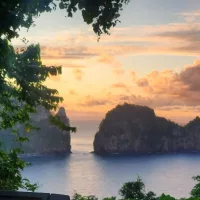
On Earth Day 2025, April 22, Congresswoman Uifa’atali Amata highlights the National Park of American Samoa as part of National Park Week (celebrated April 19–27), which includes both Earth Day (Tuesday) and Arbor Day (Friday).
“Our beautiful tropical islands are bright green and full of life, but even here there are places where the vegetation needs to be replenished or tended—after landslides, nearby construction, or just routine causes,” said Congresswoman Amata. “Last week was Holy Week, and from Genesis we read that God intended us to use wise stewardship of the land, including caring for and cultivating plant life. With Earth Day, National Park Week, and Arbor Day, we have three good reminders of these natural blessings, and how keeping an abundance of trees and vegetation worldwide can improve our fresh air.”
The Congresswoman added, “We’re so proud of our beautiful National Park of American Samoa and the ways it stands out from all the others in the United States, as the only one south of the equator. Our Park helps showcase our ancient culture and welcoming people to visitors, as well as our beautiful places and native wildlife and plants. I appreciate the efforts of all our Park employees and volunteers, knowing they work outdoors in hot conditions or potentially get caught in heavy rains.”
On January 4, 2025, a bill for which Amata was an original cosponsor became law: the bipartisan Expanding Public Lands Outdoor Recreation Experiences (EXPLORE) Act, one of the signature HNR legislative efforts of the 118th Congress, supporting recreational and outdoor activities. This year, in the 119th Congress, the Fix Our Forests Act has already passed the House, led by HNR Chairman Bruce Westerman of Arkansas. A forester by education, Chairman Westerman has made reducing wildfires and preserving forest lands a major priority.
The National Park of American Samoa is exceptional in the U.S. park system—as a multi-site park, part of several islands, home to South Pacific plants and species not found anywhere else in the U.S., and the fact that it includes offshore coral reefs.
Photo: National Park of American Samoa




